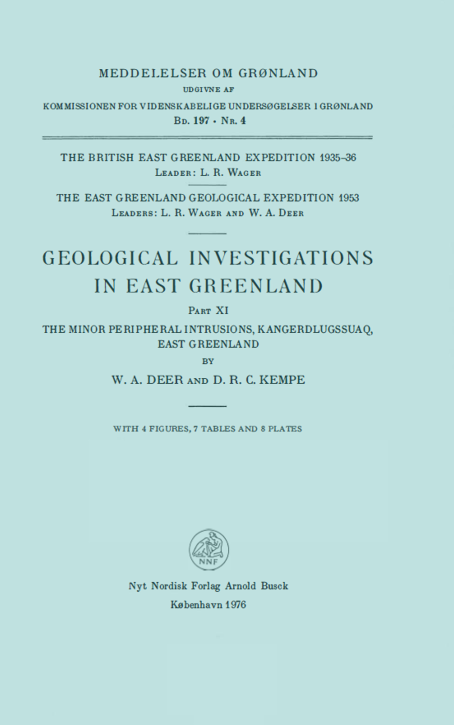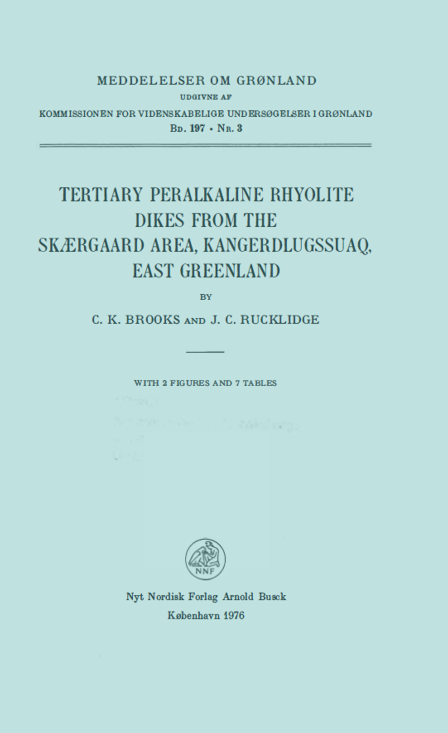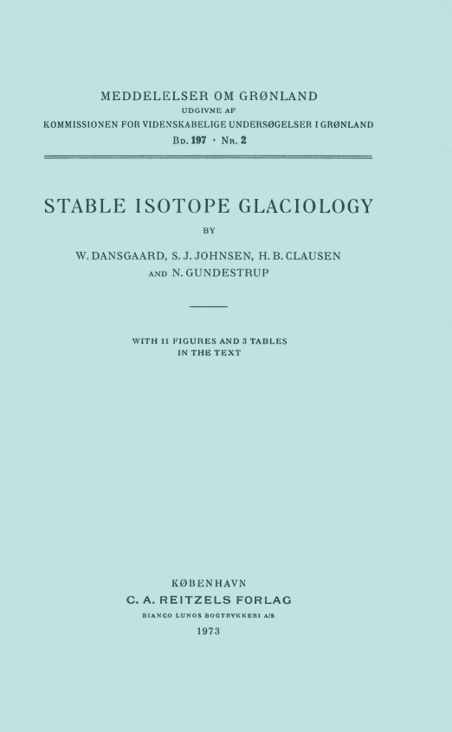Archives - Page 3
-
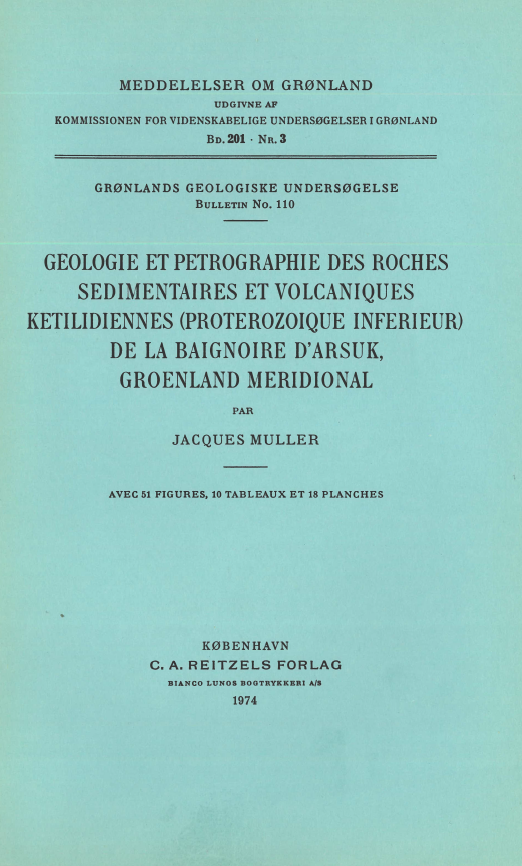
Meddelelser om Grønland
Vol. 201 No. 3 (1974)Généralités. s. 5
Situation générale d'Arsuk Ø. s. 5
Historique. s. 6
Division des roches kétilidiennes dans la région d'Arsuk. s. 12
Définition des termes employés. s. 13Lithostratigraphie. s. 15
Les divisions lithostratigraphiques. s.15
Le Groupe sédimentaire d'Ikerasârssuk. s. 16
La Formation de Taylers Havn. s.16
L'horizon d'Evqitsut. s.19
L'horizon des quartzites. s. 20
L'horizon des quartzites dolomitiques. s. 27
L'horizon des phyllites rubanés. s. 32
L'horizon des schistes sombres. s. 33
La Formation de Taylers Havn sur la côte Nord d'Arsuk Ø. s, 40
Conclusion . s. 41
La Formation d' lnugsugtût. s. 42
Situation. s. 42
Succession lithologique observée dans la partie supérieure de la Formation d'lnugsugtût à Storø. s. 42
Résumé. s. 43
La Formation d'lsua. s. 43
La Formation d'Isua sur Arsuk ø. s. 43
La Formation d'lsua à Storø . s. 46
Conclusion. s. 46Le Groupe volcanique d'Arsuk . s. 48
Coupe lithologique . s. 48
Le matériel volcanique. s. 50
Les coulées de lave avec structures en pillows. s. 51
Les coulées de pillows bréchiques ou isolés. s. 66
Les lapillis et les tufs . s. 69
Les brèches volcaniques détritiques. s. 70
Les laves massives associées aux coulées de pillows. s. 70
Les filons-couches basiques dans les formations sédimentaires. s. 75
Les filons basiques kétilidiens dans l'édifice volcanique. s. 76
Les roches ultrabasiques. s. 77
Le matériel sédimentaire et siliceux dans le Groupe d'Arsuk . s. 79
Les gneiss du vieux socle. s. 82
Les gneiss d'lvigtut . s. 82
Les gneiss de la cô te Nord d'Arsuk Ø. s. 82
Les gneiss et les amphibolites de l'îlot Narssap sagdlia. s. 84 Les gneiss de la côte Nord-Ouest de Tavdlorutit. s. 85
Les gneiss entre Taylers Havn et Taylers Fjeld. s. 86
Les gneiss avec enclaves gabbro-anorthositiques. s. 87
Les gneiss situés sous les formations d'Arsuk Ø. s. 87
Les filons basiques discordants dans le vieux socle. s. 88
Résumé. s. 90
Les minéraux détritiques dans les gneiss et les roches supracrustales. s. 90Tectonique. s. 92
Introduction. s. 92
Les éléments tectoniques analysés. s. 93
Analyse structurale . s. 93
Chronologie des déformations. s. 94
Les déformations kétilidiennes. s. 94
La première phase de déformation: plis contemporains de la schistosité. s. 94
Les plis contemporains de la schistosité dans le groupe volcanique. s, 95
Les structures contemporaines de la schistosité dans le groupe sédimentaire. s. 98
La deuxième phase de déformation: plis déformant la schistosité. s. 101
Les structures dans le complexe tectonique inférieur. s. 102
La structure synclinale ou en << baignoire >> du complexe tectonique supérieur. s. 107
La troisième phase de déformation: plis déformant le clivage. s. 109
Les structures dans le secteur de Taylers Havn. s. 109
Superposition de la 2e et de la 3e phase à Taylers Havn. s.110
Les plis de la côte Nord d'Arsuk Ø. s. 111
La tectonique cassante tardive. s. 111
Les diaclases plissées. s. 111
Les diaclases de cisaillement ENE. s. 112
Les contacts entre les roches supracrustales et les gneiss du socle. s. 112
Les contacts entre Taylers Havn et Taylers Fjeld. s.112
Les contacts au Nord d'Ikerasârssuk et à Webers Havn. s. 113
Résumé. s.113
Les déformations kétilidiennes dans les gneiss du socle. s. 113
Résumé et conclusion . s. 114
Les déformations cassantes postkétilidiennes. s. 116
La période Gardar. s. 116
Chronologie des déformations Gardar sur Arsuk Ø. s, 117
Les déformations post-Gardar. s. 120
Conclusion. s. 121
Le bassin volcano-sédimentaire d'Arsuk et son évolution métamorphique. s. 123
Dépôt des séries volcano-sédimentaires. s.123
Les cristallisations kétilidiennes. s. 124
Métamorphisme associé à la 1re phase de déformation. s. 129
Les conditions métamorphiques entre la ire et la 3e phase. s. 129
Le plissement de la 3e phase. s. 130
Recristallisations postérieures à la 3e phase. s.130
Corrélations entre les roches kétilidiennes d'Arsuk 0 et de Gramseland-Midternoes. s. 131
Remerciements. s. 133
Liste bibliographique. s.134 -
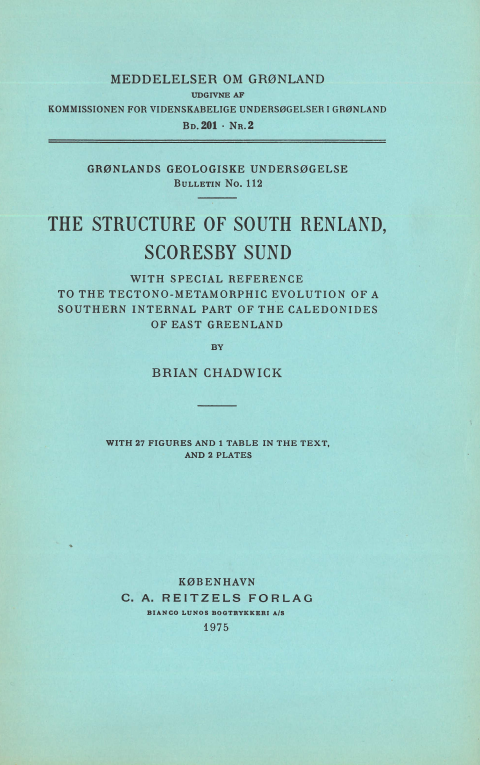
Meddelelser om Grønland
Vol. 201 No. 2 (1975)Introduction. s. 5
Scope of the paper. s. 5
Field work. s. 5
Topography. s 6
Regional setting. s. 8
Previous work. s. 9
Lithology in south Renland. s.10
Rusty brown garnetiferous gneisses and quartzites. s. 10
Garnetiferous augen granite. s. 14
Streaky augen granite. s.16
Hypersthene monzonite. s.16
Migmatites in east Renland. s. 20
Grey-pink granites. s.24
Miscellaneous granites. s. 25
Microgranites, aplites and pegmatites. s. 27
Metamorphic geology. s. 29
Structural geology. s. 31
Structure in south-west Renland. s. 31
Deglaciated tract east of Rypefjord. s. 31
The coast of Øfjord west of peak 1882. s. 38
The higher reaches of Catalinadal. s. 42
The higher reaches of Edward Bailey Gletscher. s. 45
The massif in south-east Renland. s. 45
Small-scale shear belts. s. 46
Schistosity in the augen granites. s. 48
Lineation. s. 49
The constrictional deformation. s. 50
Back-folding. s. 53
Patterns of fracture and their regional significance. s. 54
Synthesis. s. 56
Tertiary igneous rocks. s. 62
Acknowledgements. s. 63
Zusammenfassung. s. 63
References. s.65 -
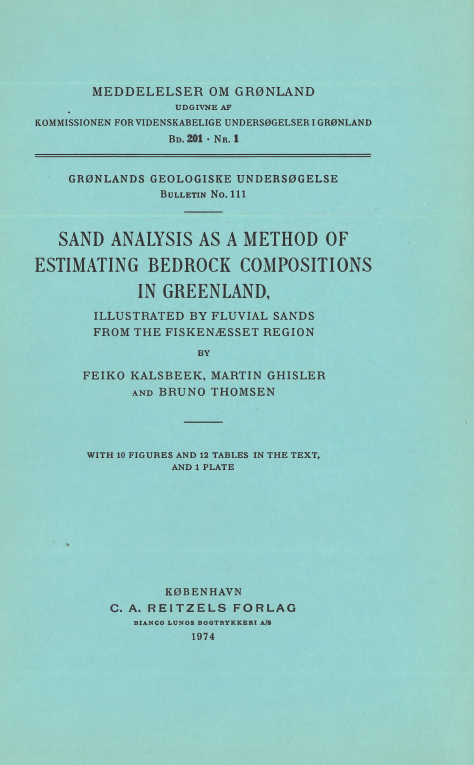
Meddelelser om Grønland
Vol. 201 No. 1 (1974)1. Introduction. s.5
2. The bulk mineralogical composition of the sands and the composition of the feldspars. s. 7
a. Method of study. s. 7
b. Results of the point counter analyses. s.8
c. The composition of the feldspars. s. 9
3. The chemical composition of the sands. s. 10
a. Method of study. s. 10
b. Results of the analyses. s. 11
4. The grain sizes of the sands. s. 12
a. Grain size and sorting. s. 12
b. Influence of the grain size on the composition of the sands. s. 13
5. The composition of the heavy fraction. s. 14
a. Method of study. s. 14
b. Properties of the heavy minerals. s. 14
c. Results of the grain counts. s.15
6. The composition of the opaque fraction. s. 18
a. Method of study. s.18
b. Results of the grain counts. s. 18
7. The provenance of the sands. s. 21
a. Sands from the Midgard area. s. 21
b. Sands from the Majorqap qâva area. s. 23
8. Estimates of the average composition of the bedrock in the Fiskenæsset area s. 26
a. The abundance of the different rock types. s. 26
b. The mineralogical composition of the rocks in the area. s. 27
c. The chemical composition of the rocks in the area. s. 28
9. Summary and conclusions. s. 29
Acknowledgements. s. 31
References. s. 31 -
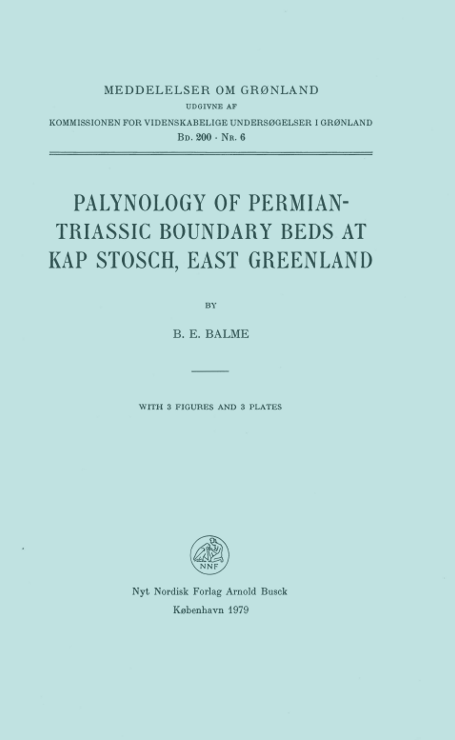
Meddelelser om Grønland
Vol. 200 No. 6 (1979)Introduction and acknowledgements. s. 5
Localities of samples examined. s. 7
Sample preparation and palynological procedures. s.10
Plant microfossil associations. s. 10
Vittatina-Association . s. 11
Composition. s. 11
Distribution. s. 12
Age and implications. s. 12
Protohaploxypinus-Association. s, 15
Composition. s. 15
Distribution. s. 15
Age and implications. s, 16
Taeniaesporites-Association. s. 16
Composition. s. 19
Distribution. s. 20
Age and implications. s. 20
Systematic descriptions and comments. s. 21
Introductory notes. s. 21
Microfossils incertae sedis. s. 22
Trilete spores. s. 24
Non-saccate pollen grains. s. 26
Unassigned monosulcate pollen grains. s. 27
Non-taeniate saccate pollen. s. 29
Taeniate saccate pollen. s. 31
References. s. 35 -
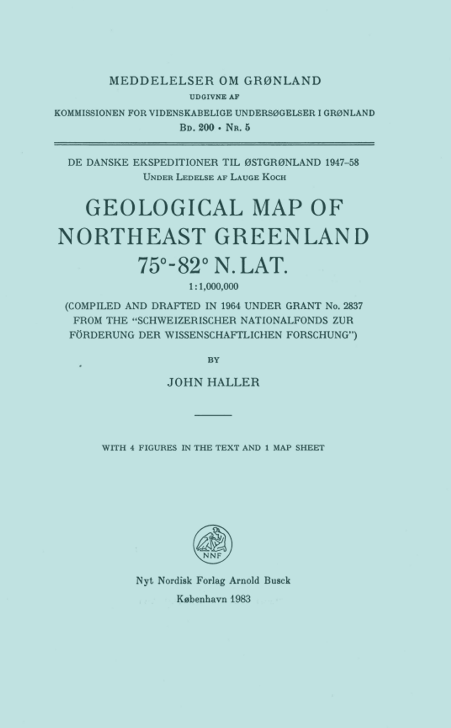
Meddelelser om Grønland
Vol. 200 No. 5 (1983)Introduction. s. 5
Geological investigations of Northeast Greenland, 1870 to 1960. s. 6
The geologic map of Northeast Greenland. s. 9
Caledonian structures. s. 9
Post-Caledonian formations. s. 12
Remarks on the "Carolinidian Orogenic Belt". s. 12
References. s. 19 -
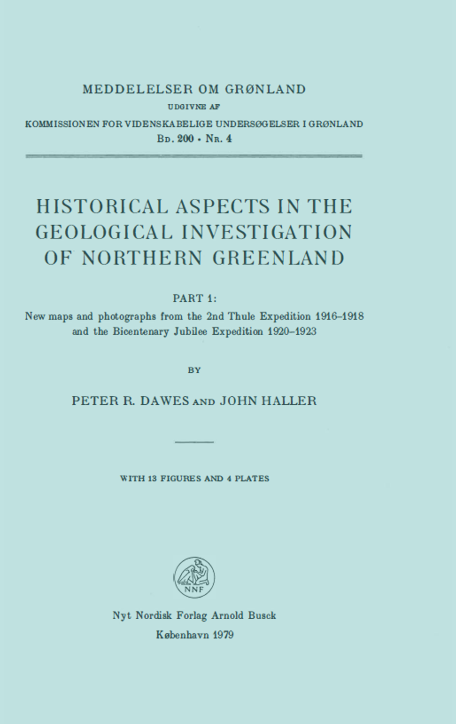
Meddelelser om Grønland
Vol. 200 No. 4 (1979)Introduction 5
The map and photographic material. s. 6
Historical background. s, 9
Results of the 2nd Thule and Bicentenary Jubilee Expeditions. s. 13
Discussion of the material. s. 18
Kap York district map. s. 18
Washington Land and North Greenland maps. s. 19
Geological conditions at Kap Schuchert. s. 30
Geological conditions along the northern coast of Hall Land. s. 34
Acknowledgements. s. 36
References. s. 37 -
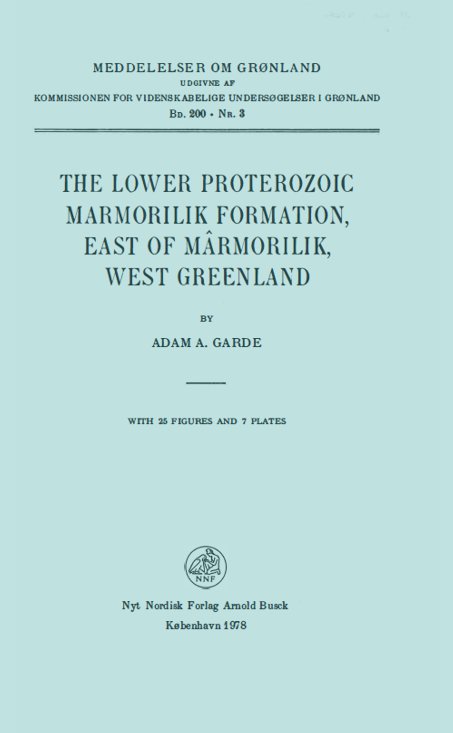
Meddelelser om Grønland
Vol. 200 No. 3 (1978)I. Introduction. s. 5
General. s. 5.
Geological setting. s. 5 Topography in the area east of Marmorilik. s. 7
Mapping and topographic base. s. 7
II. Stratigraphy. s. 7
Procedure followed in establishing the stratigraphy. s. 7
Summary of the stratigraphy of the Marmorilik Formation. s. 10
Basement and the basal unconformity. s. 11
The basal Quartzite-Semipelite Member. s. 12
At type section 1. s. 12
South of the 480 m lake. s. 13
West of the 746 m lake. s. 13
Petrography in the Quartzite-Semipelite Member. s. 14
The Lower Dolomite Member. s. 15
At type section 1. s. 15
West of the 470 m lake. s. 16
At type section 2 (south-east of the 480 m lake). s. 16
Between the 480 and 746 m lakes. s. 16
Petrography in the Lower Dolomite Member. s. 17
The Thin Calcite Marble Member. s. 18
The Grey Dolomite Member. s. 19
At type section 2 and between the 480 and 746 m lakes. s. 19
At type section 3 north of the 470 m lake. s. 19
Petrography in the Grey Dolomite Member. s. 19
Inverted sequences and tectonic breccia at type section 3. s. 20
The Banded Marble Member. s, 20
Petrography in the Banded Marble Member. s. 21
The Massive Calcite Marble Member. s. 22
At type section 3. s. 22
North of the 480 m lake. s. 22
Petrography in the Massive Calcite Marble Member. s. 22
The Semipelite Member (Black Angel mountain). s. 25
Petrography in the Semipelite Member. s. 26
The north face of the Black Angel mountain. s. 26
Dolerite Dykes. s. 28
Quaternary deposits. s. 28
III. Metamorphism. s. 28
Introduction; field observations. s. 28
Mineral parageneses. s. 30
Mineral compositions. s. 32
Conditions of metamorphism. s. 32
Timing of metamorphism. s. 35
IV. Structure. s. 35
General structure. s. 35
The large open syncline. s. 35
Faults. s. 36
Recumbent folds and thrusts. s. 36
Open folds and monoclines. s. 40Structures in restricted areas. s. 40
A tight syncline between the 480 and 746 m lakes. s. 40
Angular folds east of Agfardlikavsâ. s. 41
Structure of the Black Angel mountain. s. 41
Structure of the cliff facing Agfardlikavsâ. s. 41
Structure of the north-west facing cliffs. s. 43
Structural position of the Black Angel. s. 44
Small-scale structures. s. 44
Cross-cutting foliations. s. 44
Linear structures: general orientation. s. 44
Rodding and mineral lineation. s. 46
Tight to isoclinal folds. s,. 48
Tectonic breccia. s. 52
Slip along joints in competent beds. s. 52
Minor structures in the area of the tight syncline. s. 52
Time relationship between various types of structure. s. 53
Common relations of recumbent folds and thrusts. s. 54
Relations between thrusts and the tight syncline. s. 54
Evidence from linear structures. s. 54
Faults: relation to other structures. s. 54
Conclusion. s. 55
V. Mineralisation. s, 55
Introduction. s. 55
Descriptions. s. 55
Low-grade mineralisations. s. 55
Massive mineralisations. s.56
Stratigraphic control of mineralisations. s.58
Metal contents of ordinary marbles. s. 58
Conclusions. s. 59
Analytical procedure. s. 60
VI. Origin of the Marmorilik Formation. s. 60
Regional aspects. s. 60
Some characteristics of the Marmorilik Formation relevant to its origin. s. 60
Distribution of calcite and dolomite marble. s. 61
Massive, weakly banded carbonates with graphite and/or pyrite. s. 61
Absence of stromatolites. s.62
Distribution and possible significance of scapolite. s. 62
Semipelite-banded carbonate rocks, semipelite and related rocks. s.63
Quartz in the Marmorilik Formation. s. 63
Origin of the carbonates in the Marmorilik Formation. s. 64
Primary calcium carbonate. s.64
Conditions of deposition of the carbonates. s.64
a) The role of organisms. s.64
b) Water depth. s. 65
c) Dolomitisation. s. 65
The Marmorilik Formation in the context of Precambrian carbonate formations. s. 66
Acknowledgements. s. 68
References. s.69 -
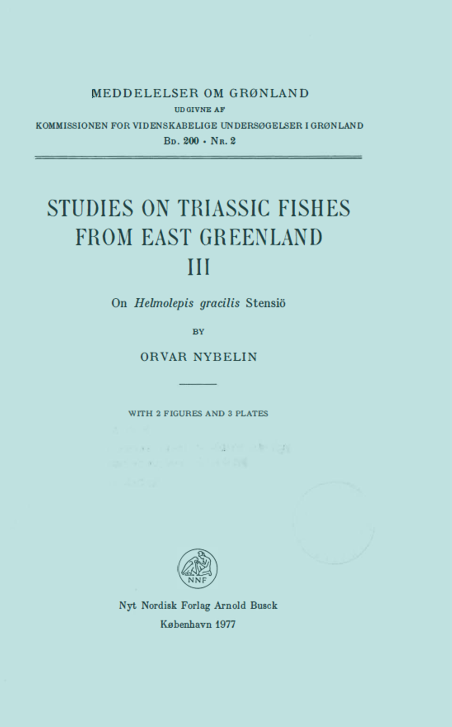
Meddelelser om Grønland
Vol. 200 No. 2 (1977)Introduction. s. 3
Description. s. 4
Discussion. s. 10
Acknowledgements. s. 13
References. s. 14 -
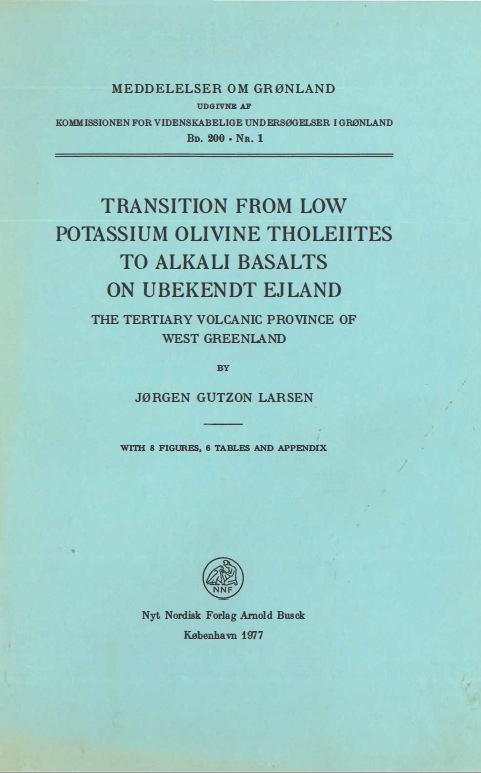
Meddelelser om Grønland
Vol. 200 No. 1 (1977)Introduction. s. 5
Regional setting. s. 5
Stratigraphy. s. 8
Nomenclature. s. 8
Petrography. s. 10
The low potassium tholeiites and the transitional basalts. s. 10
The alkali basalts. s. 11
1. The plagioclase-rich types. s. 11
2. The olivine-clinopyroxene porphytic types. s. 11
The hawaiites. s. 13
Petrochemistry. s. 14
Introduction. s. 14
The chemical variation. s. 15
Comparative basalt chemistry. s. 16
Discussion. s. 19
Modal calculations. s. 19
A common parental magma? s. 25
Depth of origin. s. 29
Conclusions. s. 30
Acknowledgements. s. 31
References. s. 32
Appendix. s. 37 -
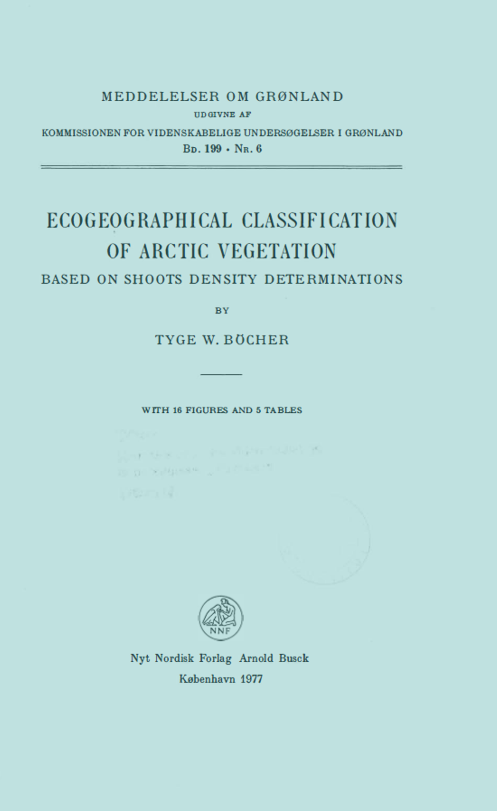
Meddelelser om Grønland
Vol. 199 No. 6 (1977)Introduction. s. 5
The shoots density determination. s. 5
Ecogeographical distributional types. s. 6
Marginal habitats of four species usually connected with dry, exposed and poor soils. s. 8
Snow cover-dependent dwarf shrub heath pattern. s. 18
Snow cover-independent dwarf shrub-sedge heath pattern. s. 24
Snow cover-dependent willow-forb vegetation complex. s. 36
Analyses of small ecologically specialized stands. s. 44
Ecological specialization and degrees of exclusiveness in relation to ecogeographical distributional types. s. 53
Literature. s. 59
Index to vascular species mentioned in some detail. s. 61 -
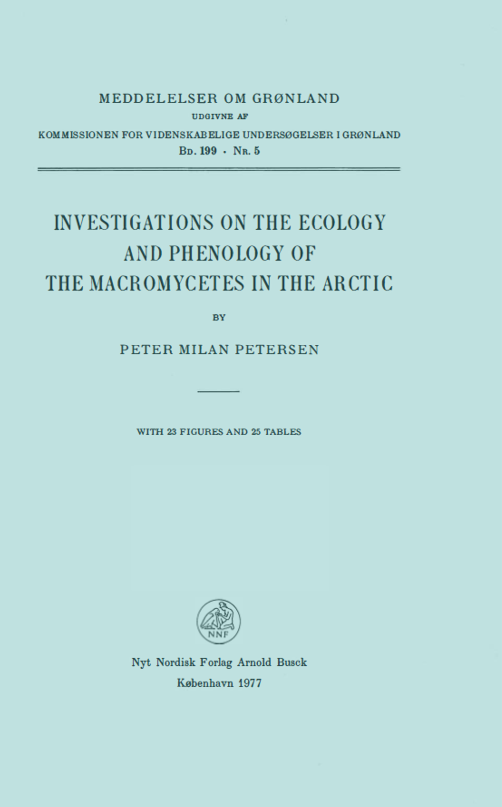
Meddelelser om Grønland
Vol. 199 No. 5 (1977)Introduction. s. 5
Acknowledgements. s. 5
Previous works. s. 6
General description of the investigation area. s. 6
Methods. s. 8
Species list. s. 10
The sites and their macromycete flora. s. 13
Discussion of some site characteristics. s. 31
Phenology of the macromycete flora. s. 44
The Fructification in relation to some environmental factors. s. 51
Discussion. s. 64
Conclusion. s. 70
Literature. s. 71
Postscript. s. 72 -
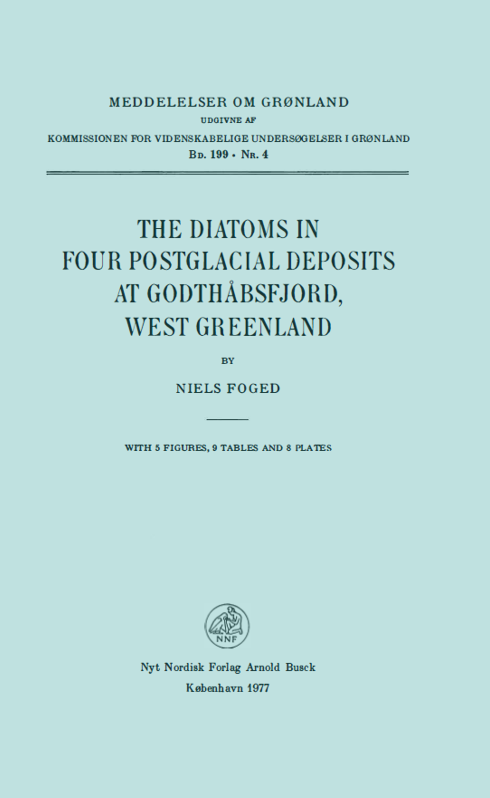
Meddelelser om Grønland
Vol. 199 No. 4 (1977)lntroduction. s. 5
Johannes Iversen Sø (Lake A). s. 7
Gytjesø (Lake B). s. 18
Sårdlup timâne taserssuaq (Lake C). s. 30
Kigssaviat taserssua (Lake D). s. 42
Taxonomical remarks. s. 52
Acknowledgments. s. 62
Literature. s. 63
Plates. s. 65 -
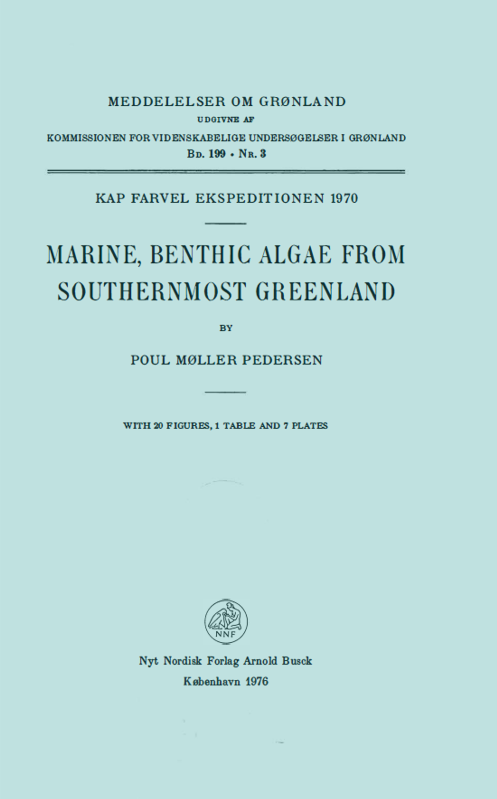
Meddelelser om Grønland
Vol. 199 No. 3 (1976)Introduction. s. 5
Material and Methods. s. 6
Results. s. 6
Shore types substratum and influence of sediment. s. 6
Temperature. s. 8
Ice conditions. s. 8
Systematic part. s. 10
Cyanophyceae. s. 10
Chroococcales. s. 10
Pleurocapsales. s. 10
Nostocales. s. 11
Rhodophyceae. s. 12
Bangiales. s. 12
Nemaliales. s. 13
Cryptonemiales. s. 19
Gigartinales. s. 23
Rhodymeniales. s. 25
Ceramiales. s. 26
Dinophyceae. s. 28
Dinococcales. s. 28
Chrysophyceae. s. 29
Phaeosacciaceae. s. 29
Xanthophyceae. s. 29
Vaucheriaceae. s. 29
Phaeophyceae. s. 30
Ectocarpales. s. 30
Desmarestiales. s. 43
Sphacelariales. s. 44
Scytosiphonales. s. 44
Dictyosiphonales. s. 46
Laminariales. s. 50
Fucales. s. 52
Chlorophyceae. s. 52
Chlorococcales. s. 52
Prasiolales. s. 53
Ulotrichales. s. 54
Siphonocladales. s. 61
References. s. 62
Species index. s. 67
Appendix. s. 69 -

Meddelelser om Grønland
Vol. 199 No. 2 (1974)Introduction. s. 5
Localities. s. 7
Plant records. s. 9
Remarks on the more interesting species. s. 9
Concluding remarks. s. 29
Hot springs in Greenland. s. 30
East Greenland. s. 30
Rømer Fjord northern springs. s. 30
Rømer Fjord southern springs. s. 31
Knighton Fjord. s. 32
Other springs. s. 38
South Greenland. s. 38
West Greenland. s. 40
The phytogeographical significance of the Blosseville Kyst hot springs. s. 41
Acknowledgments. s. 44
Literature. s. 45
Plant index. s. 48 -
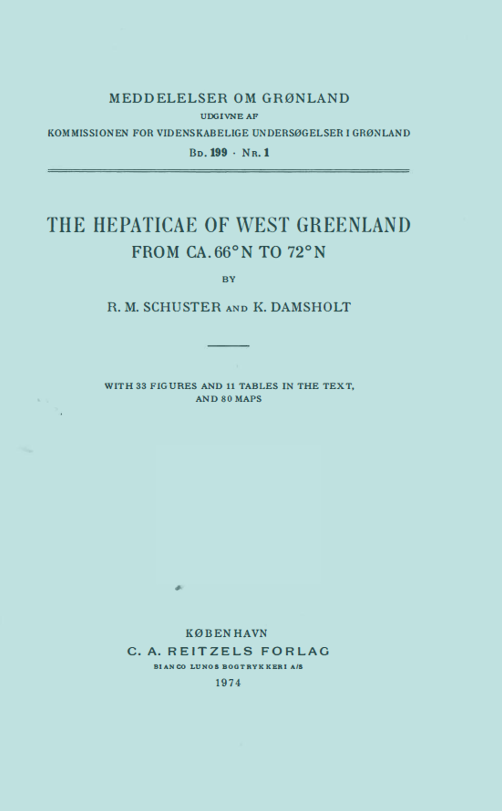
Meddelelser om Grønland
Vol. 199 No. 1 (1974)Introduction. s. 5
Acknowledgements. s. 7
Methodology. s. 8
Historical background. s. 11
Phytogeographical climatic and geological considerations. s. 15
Collecting stations and mode of citation. s. 25
Taxonomic treatment. s. 34
Introduction. s. 34
ORDER CALOBRYALES. s. 39
Family Haplomitriaceae. s. 39
ORDER JUNGERMANNIALES. s. 40
Family Blepharostomataceae. s. 40
Family Ptilidiaceae. s. 45
Family Calypogeiaceae. s. 48
Family Jungermanniaceae. s. 54
Subfamily Chandonanthoideae. s. 54
Subfamily Lophozioideae. s. 55
Subfamily Jamesonielloideae. s. 159
Subfamily Jungermannioideae. s. 160
Subfamily Mylioideae. s. 185
Family Gymnomitriaceae. s. 185
Family Scapaniaceae. s. 197
Family Plagiochilaceae. s. 279
Family Arnelliaceae. s. 280
Family Antheliaceae. s. 281
Family Cephaloziaceae. s. 284
Family Cephaloziellaceae. s. 302
ORDER METZGERIALES. s. 335
Family Blasiaceae. s. 335
Family Aneuraceae. s. 336
ORDER MARCHANTIALES. s. 341
Family Aytoniaceae. s. 342
Family Sauteriaceae. s. 353
Family Marchantiaceae. s. 357
Family Ricciaceae. s. 361
References. s. 365
Index. s. 371
Maps. s. 375 -
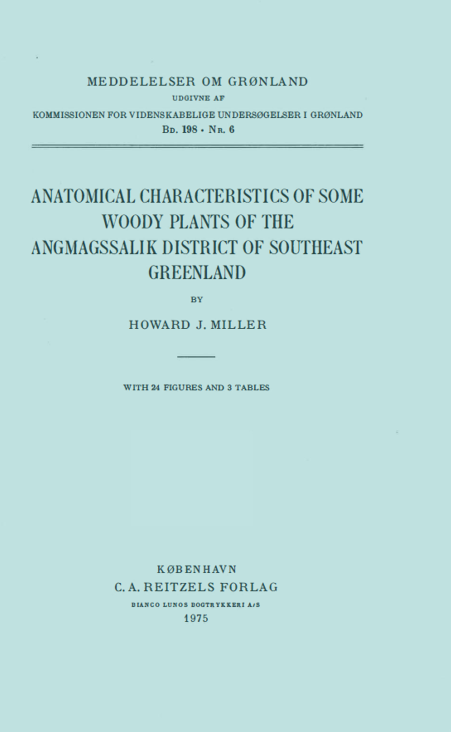
Meddelelser om Grønland
Vol. 198 No. 6 (1975)Introduction. s. 4
Acknowledgements. s. 4
Collection localities of the investigated wood specimens. s. 5
Growth ring observations. s. 7
Wood descriptions. s. 12
Juniperus communis L. ssp. nana SYME. s. 12
Betula nana L. s. 14
Empetrum nigrum L. ssp. hermaphroditum (HAGERUP) BÖCHER. s. 15
Cassiope tetragona (L.) D. DON. s. 16
Loiseleuria procumbens (L.) DESV. s. 17
Rhododendron lapponicum (L.) WBG. s. 19
Vaccinium uliginosum L. ssp. microphyllum LANGE. s. 20
Dryas integrifolia M. VAHL. s. 21
Salix glauca L. s. 22
Salix herbacea L. s. 23
Evaluation of anatomical characteristics. s. 25
Literature. s. 29 -

Meddelelser om Grønland
Vol. 198 No. 5 (1975)Introduction. s. 5
Investigated localities (B. F.). s. 5
Kap Farvel area. s. 5
Qagssiarssuk. s. 8
Peary Land. s. 10
Methods. s. 10
The mosses (N. J.). s. 12
Methods. s. 12
Kap Farve! area. s. 12
Qagssiarssuk. s. 24
Peary Land. s. 25
The zoological remains (U.R.). s. 28
Methods. s. 28
Description of the zoological remains. s. 32
Discussion of the zoological remains. s. 38
Acknowledgements. s. 42
References. s. 43 -

Meddelelser om Grønland
Vol. 198 No. 4 (1973)Introduction. s. 7
Methods. s. 9
Field work. s. 9
Laboratory work. s. 11
Macrofossil analysis. s. 11
Pollen analysis. s. 11
Chemical analysis. s. 13
Radiocarbon dating. s. 13
Identifications. s. 13
Macrofossils. s. 20
Pollen, spores and other microfossils. s. 22
The pollen diagrams. s. 31
The relative diagrams. s. 31
The absolute diagrams. s. 33
Investigated localities. s. 36
South Greenland. s. 36
The Kap Farvel area. s. 36
Remarks on the present vegetation. s. 36
Remarks on the climate. s. 39
Remarks on the geology. s. 39
Isoëtes Sø. s. 40
Spongilla Sø. s. 54
Kløftsø. s. 62
Sphagnum Dam. s. 69
Triangelsø. s. 71
Drepanocladus Dam. s. 72
Summary of the vegetational and climatic history of the Kap Farvel area. s. 81
The terrestrial vegetation. s. 81
The lacustrine vegetation. s. 86
The head of Tunugdliarfik. s. 91
Comarum Sø and Comarum Mose. s. 91
Comarum Sø. s. 94
Comarum Mose. s. 100
Galium Kær. s. 109
Macrofossils from Norse culture layers. s. 124
Transect ERA. s. 124
Transect QD. s. 126
Transect LM. s. 127
Narssaq. s. 128 Norse plants. s. 128
Summary of the vegetational and climatic history of Qagssiarssuk. s. 131
The terrestrial vegetation. s. 131
The lacustrine vegetation. s. 133
West Greenland. s. 136
The Godthåbsfjord area. s. 136
Remarks on the present vegetation. s. 136
Remarks on the climate. s. 137
Remarks on the geology. s. 138
"Lake 100 m s.m.". s. 138
Igdlorssuit tasiat. s. 141
"Lake 8 m s.m.". s. 144
Lake in Itivneq. s. 153
Lake at Itivnera. s. 155
Former ponds at Itivnera. s. 156
Transect at Itivnera. s. 158
Transects in Norse culture layers. s. 162
Eqalugialik. s. 162
Ujaragssuit. s. 163
Umiviarssuk. s. 165
Summary of the vegetational and climatic history around the head of Godthåbsfjord. s. 166
The terrestrial vegetation. s. 166
The lacustrine vegetation. s. 167
Sermermiut. s. 167
North Greenland. s. 169
Thule area and Inglefield Land. s. 169
Peary Land. s. 172
Remarks on the present vegetation. s. 172
Remarks on the climate. s. 173
Remarks on the geology. s. 173
Klaresø. s. 174
Sølejren. s. 183
Summary of the vegetational and climatic changes in North Greenland. s. 189
Former pollen sedimentation. s. 191
Exotic and long distance pollen in the diagrams. s. 191
Variation and changes in pollen sedimentation. s. 201
Recent pollen sedimentation. s. 203
Recent gyttja samples. s. 203
Pollen traps. s. 207
Qagssiarssuk. s. 207
North Greenland. s. 211
Matrix sedimentation rates. s. 213
Concluding remarks on the Holocene vegetational and climatic changes in Greenland. s. 214
Dansk resume. s. 223
Summary. s. 232
References. s. 239 -
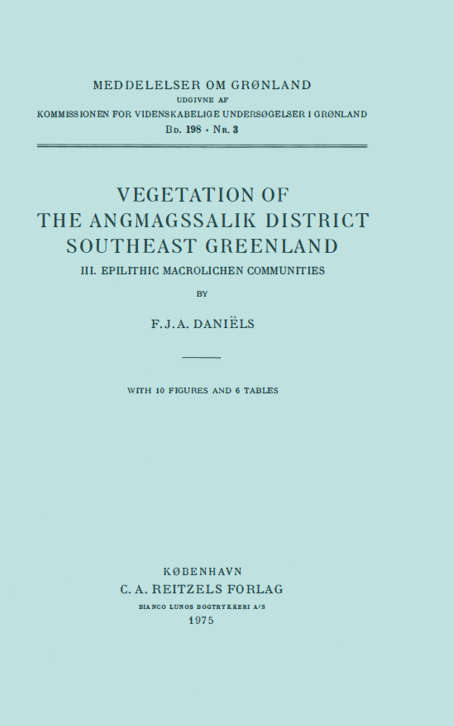
Meddelelser om Grønland
Vol. 198 No. 3 (1975)Acknowledgements. s. 4
1. INTRODUCTION. s. 5
2. PREVIOUS PHYTOSOCIOLOGICAL WORK ON EPILITHIC LICHENS IN ARCTIC AND ALPINE AREAS. s. 5
2.1. Greenland. s. 5
2.2. Other arctic areas. s. 6
2.3. Fennoscandia and Iceland. s. 6
2.4. Central Europe. s. 7
3. THE ANGMAGSSALIK DISTRICT. s. 7
4. LOCALITIES. s. 10
5. METHODS. s. 11
5.1. Methods in the field. s. 11
5.1.1. Analysis of the vegetation. s. 11
5.1.2. Analysis of environment. s. 11
5.2. Elaboration of field data. s. 12
6. SOME ECOLOGICAL NOTES. s. 13
7. MACROLICHEN VEGETATION. s. 15
7.1. Class Rhizocarpetea geographici. s. 15
7.1.1. Order Umbilicarietalia cylindricae. s. 15
7.1.1.1. Alliance Umbilicarion cylindricae. s. 15
7.1.1.1.1. Community 1: Alectoria pubescens sociation. s. 15
7.1.1.1.2. Community 2: Ass. Umbilicarietum cylindricae. s. 18
7.1.2. Alliance Crocynio-Hypogymnion. s. 20
7.1.2.1. Ass. Parmelietum omphalodis. s. 20
7.1.2.1.1. Community 3: Subass. sphaerophoretosum fragilis. s. 21
7.A. Note. s. 23
7.A.1. Community 4: Ass. Umbilicarietum arcticae. s. 23
7.A.2. Community 5: Community of Xanthoria elegans. s. 26
Literature. s. 30 -
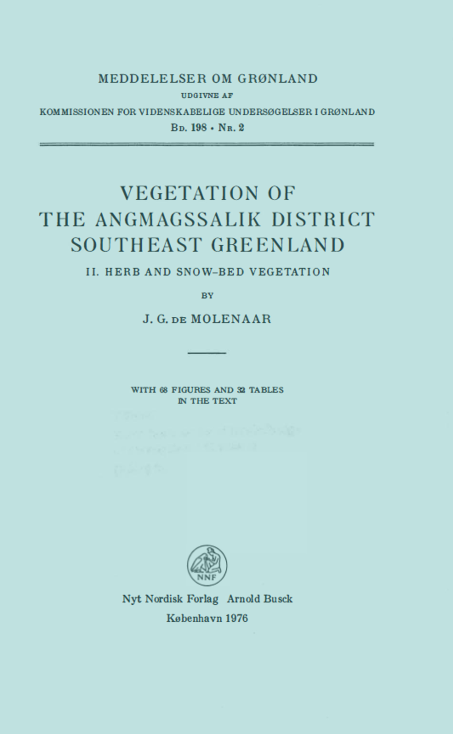
Meddelelser om Grønland
Vol. 198 No. 2 (1976)- General part 7
- s. 7
1.1. Geography. s. 7
1.2. Physiography. s. 8
1.3. Climate. s. 9
1.4. Geology. s. 10
1.5. Soil. s. 11 - s. 14
2.1. Previous investigations. s. 14
2.2. The present investigation. s. 15 - s. 16
- s. 23
- Description of the vegetation units. 28
Chapter I. Aquatic and amphibious vegetation. s. 28 - Class Charetea.. s. 29
1. Order Charetalia. s. 29 - Class Potametea. s. 29
1. Order Parvopotametalia. s. 29
2.1.1. All. Parvopotamion. s. 30
2.1.1.1. Ass. Potametum filiformis. s. 30
2.1.2. All. Callitricho-Batrachion. s. 31
2.1.2.1. Ass. Callitricho-Sparganietum angustifolii. s. 31
2.1.2.2. Ass. Ranunculetum confervoidis. s. 34 - Class Littorelletea. s. 36
1. Order Littorelletalia. s. 36
3.1.1. All. Subularion aquaticae. s. 36
3.1.1.1. Ass. Callitricho-Subularietum aquaticae. s. 38
3.1.1.2. Ass. Ranunculo-Alopecuretum aequalis. s. 40
3.1.1.3. Ass. Subulario-Juncetum subtilis. s. 42
Chapter II. Spring vegetation. s. 43
- Class Montio-Cardaminetea. s. 45
1. Order Montio-Cardaminetalia. s. 45
4.1.1. All. Montio-Epilobion hornemanni. s. 45
4.1.1.1. Ass. Mniobryo-Epilobietum hornemanni. s. 45
4.1.1.2. Ass. Philonoto-Saxifragetum stellaris. s. 48
4.1.1.3. Ass. Phleo-Marchantietum alpestris. s. 50
4.1.1.4. Ass. Scapanietum uliginosi. s. 52
4.1.2. All. Cratoneurion. s. 54
4.1.2.1. Suball. Cratoneuro-Saxifragion aizoidis. s. 54
4.1.2.1.1. Ass. Catoscopio-Saxifragetum aizoidis. s. 55
4.1.2.A. Note. s. 57
4.1.2.A.a. Blindia acuta-Saxifraga aizoides community. s. 57Chapter III. Mire vegetation. s. 59
- Class Parvocaricetea. s. 61
1. Order Tofieldietalia. s. 62
5.1.1. All. Caricion bicolori-atrofuscae. s. 62
5.1.1.1. Juncus castaneus-Juncus biglumis community. s. 66
5.1.1.2. Ass. Junco-Caricetum bicoloris. s. 68
5.1.1.3. Ass. Caricetum microglochinis. s. 74
5.1.1.4. Ass. Equiseto-Caricetum rarifforae. s. 77
5.1.2. All. Campylio-Tomenthypnion. s. 79
5.1.2.1. Suball. Campylio-Drepanocladion. s. 81
5.1.2.1.1. Ass. Drepanoclado-Campylietum stellatae. s. 81
5.1.2.2. Suball. Sphagno-Tomenthypnion. s. 85
5.1.A. Succession and zonation in the Tofieldietalia. s. 87
5.2. Order Caricetalia nigrae. s. 92
5.2.1. All. Caricion curto-nigrae. s. 92
5.2.1.1. Drepanocladus exannulatus sociation complex. s. 93
5.2.1.2. Calliergon sarmentosum sociation complex. s. 99
5.2.1.3. Calliergon stramineum sociation complex. s. 105
5.3. Related communities rich in Sphagna. s. 109
5.3.1. Sphagnum riparium sociation complex. s. 110
5.3.2. Sphagnum lindbergii sociation complex. s. 115
Chapter IV. Snow-bed vegetation. s. 117
- Class Salicetea herbaceae s. 122
1. Order Salicetalia herbaceae s. 122
6.1.1. All. Cassiopo-Salicion herbaceae s. 123
6.1.1.1. Ass. Cassiopnthelio-Aetum juratzkanae s. 126
6.1.1.2. Ass. Pleuroclado-Polytrichetum nor11egici s. 133
6.1.1.3. Ass. Cacciopetum hypnoidis s. 136
6.1.1.4. Ass. Gnaphalietum supini s. 142
6.1.2. All. Ranunculo-Oxyrion digynae s. 149
6.1.2.1. Ass. Sibbaldietum procumbentis s. 151
6.1.2.2. Ass. Alchemilletum alpinae s. 155
6.1.2.3. Ass. Ranunculo-Salicetum herbaceae s. 161
6.1.2.4. Ass. Chamaenerietum latifolii s. 170
6.1.2.5. Alchemilla glomerulans sociation s. 173
6.1.2.6. Alchemilla filicaulis sociation s. 179
Chapter V. Debris, scree and alluvium vegetation. s. 181
- Class Thlaspeetea rotundifolii s. 182
1. Order Androsacetalia alpinae s. 182
7.1.1. All. Antitrichio-Sedion roseae s. 183
7.1.1.1. Ass. Hylocomio-Salicetum herbaceae s. 183
7.1.1.2. Ass. Kiaerio-Salicetum herbaceae s. 187
7.1.2. All. Stellaro-Oxyrion s. 189
7.1.2.1. Ass. Oxyrietum tri11iale s. 190
7.1.2.2. Ass. Deschampsietum alpinae s. 193
7.1.2.3. Ass. Caricetum rufinae s. 195
7.1.2.4. Ass. Luzulo-Ranunculetum glacialis s. 197
7.1.A. Ass. Taraxaco-Cystopteretum fragilis s. 198
7.1.B. Note s. 201
7.2. Order Myricarietalia germanicae s. 202
7.2.1. All. Calamagrostion neglectae s. 203
7.2.1.1. Ass. Pohlio-Caricetum rufinae s. 203
7.2.1.2. Ass. Calamagrostetum neglectae s. 210
7.2.1.3. Ass. Calamagrosto-Ditrichetum s. 212Chapter VI. Grass heaths s. 216
- Class Juncetea trifidi s. 218
1. Order Deschampsio-Myrtilletalia s. 219
8.1.1. All. Nardo-Caricion gibelowii s. 219
8.1.1.1. Ass. Hieracio-Caricetum bigelowii s. 221
8.1.1.2. Ass. Caricetum bigelowii s. 224 - Class Elyno-Seslerietea s. 237
1. Order Elyno-Dryadetalia s. 237
9.1.1. All. Potentillo-Polygonion vivipari s. 237
9.1.1.1. Potentilla crantzii-Carex scirpoidea community s. 238
Chapter VIII. Xerophytic talus-slide and rock vegetation s. 238
- Class Koelerio-Corynephoretea s. 240
1. Order Sedo-Poietalia glaucae s. 241
10.1.1. All. Sedo-Thymion drucei s. 241
10.1.1.1. Ass. Luzulo-Thymetum drucei s. 242
10.1.1.2. Ass. Fimbriario-Sedetum annui s. 246
10.1.1.3. Ass. Sedo-Saxifragetum neogaeae s. 250
10.1.A. Note s. 256
10.1.A.a. Rumex acetosella-Carex scirpoidea-Veronica fruticans community s. 256
10.2. Order Sedo-Scleranthetalia s. 256
10.2.1. Sedum acre community s. 256
Acknowledgements. s. 258
Literature. s. 259 -
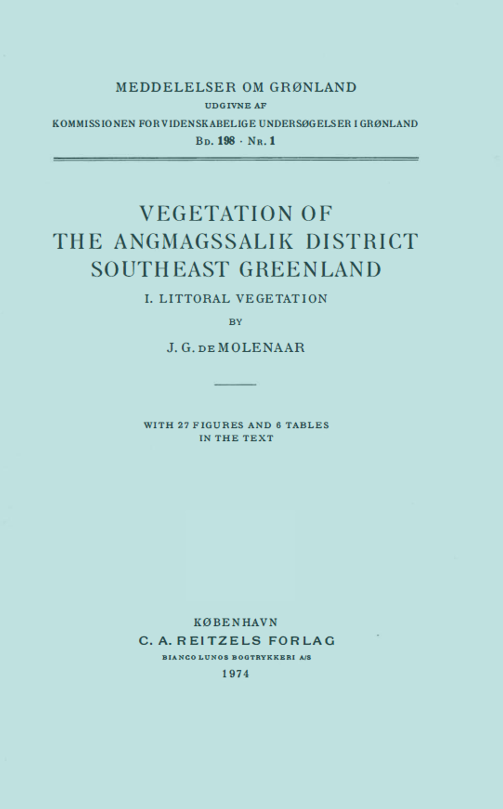
Meddelelser om Grønland
Vol. 198 No. 1 (1974)Acknowledgements. s. 4
A. General comments. s. 5- Introduction. s. 5
1.1. Geographical Comments. s. 5
1.1.1. Definition of the geographic regions. s. 5
1.1.2. The Angmagssalik District. s. 5
1.2. Botanical Comments. s. 7
1.2.1. General. s. 7
1.2.2. Previous Investigations. s. 8
1.2.3. The Present Investigation. s. 11 - The Localities. s. 15
- The Environment. s. 20
3.1. The Physiography of the Littoral. s. 20
3.2. The Climate. s. 26
3.3. The Open Water. s. 29
3.4. The Soil. s. 31
- Description of the littoral vegetation. s. 35
- Occurrence. s. 35
- Zonation and succession. s. 35
- Class Asteretea tripolii. s. 38
3.1. Order Carici-Puccinellietalia. s. 38
3.1.1. All. Puccinellion phryganodis. s. 39
3.1.1.1. Ass. Puccinellietum phryganodis. s. 39
3.1.1.2. Ass. Puccinellietum coarctatae. s. 42
3.1.1.3. Ass. Caricetum subspathaceae. s. 44
3.1.1.4. Ass. Sagino-Phippsietum algidae. s. 49
3.1.2. All. Caricion glareosae. s. 51
3.1.2.1. Ass. Caricetum glareosae. s. 51
3.1.2.2. Ass. Potentillo-Caricetum rarifiorae. s. 63 - Class Honckenyo-Elymetea arenarii. s. 67
4.1. Order Honckenyo-Elymetalia arenarii. s. 67
4.1.1. All. Honckenyo-Elymion arenarii. s. 67
4.1.1.1. Mertensia maritima sociation. s. 68
4.1.1.2. Honckenya peploides var. diffusa sociation. s. 70
- Survey of the Carici-Puccinellietalia in the Northern Atlantic area. s. 73
Literature. s. 77
- Introduction. s. 5
-
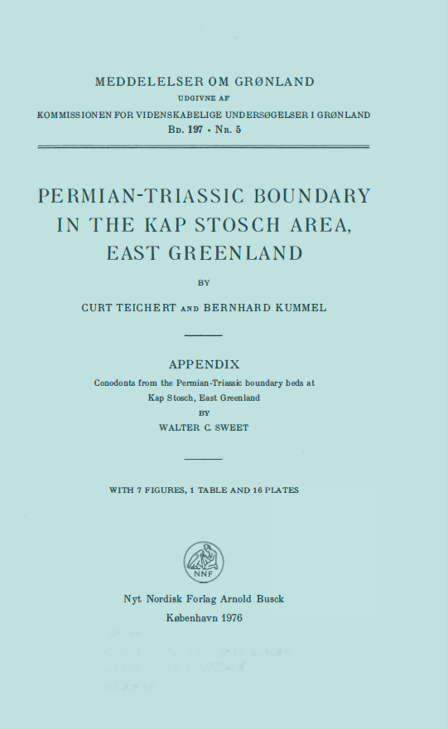
Meddelelser om Grønland
Vol. 197 No. 5 (1976)Content:
Teichert, Curt & Bernhard Kummmel: Permian-Triassic boundary in the Kap Stosch area, East Greenland, p. 1-49 + platesSweet, Walter C.: Appendix.Conodonts from the Permian-Triassic boundary beds at Kap Stosch, East Greenland, p. 51-54

